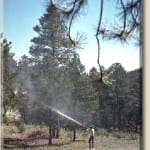Tree Information
Tree Pests
At the Johnson Tree Company (JTC), we’ve accumulated years of tree-care experience in the Black Hills and in western South Dakota. We can accurately identify and diagnose your tree’s pest and bug problems and then recommend a course of action to eliminate them. JTC arborists are usually able to assist you immediately, using our own equipment and in-house treatment plans. On the rare occasion when JTC capabilities are insufficient, we’re happy to refer you to a different chemical contractor whose equipment and/or schedules are better able to assist you.

JTC chemical applicators are commercially licensed by the South Dakota Department of Agriculture. Our applicators are current and legal in all aspects of urban and rural pesticide applications. All JTC applications of pesticide are in strict accordance with product labels regarding timeliness, environmental conditions, application rates, coverages, and dosages, and mixture formulations, volumes, and ratios. JTC is certified by state and federal agencies to properly apply any appropriate pesticide for SD’s urban and forest trees. We can professionally and correctly identify and manage any pest on any tree in the SD landscape.

Mountain Pine Beetle
(Dendroctonus ponderosae)
The biggest problem, by far, facing the Black Hills region is pine beetle infestation. Widespread outbreaks of the Mountain Pine Beetle (Dendroctonus ponderosae) and the Pine Engraver Beetle (Ips pini) are devastating entire neighborhoods in Rapid City’s (and other communities) urban forests. These same pests are annihilating thousands of acres in the Black Hills National Forest.

Pine Engraver Beetle (Ips pini)
The outbreaks of these native beetle pests have recently reached epidemic levels. The current pandemic is having considerable impact on the management and economics of the national forests. More personally, these two pests alone are creating havoc on the values of our residential homes and properties.
With minor exceptions, the identification and remedial treatment is the same for either of these beetle pests. If the chosen course of action is preventive spraying, it is best to hire JTC applicators due to the need for the spray to reach from the ground well into the crown of the tree. The beetles often begin their infestation high in the tree top and then move down the trunk of the tree as the infestation grows.
JTC applicators, using high pressure sprayers, can reach high enough in adjacent trees to limit beetle attacks, but can rarely save trees already infested. Additionally, after cutting down newly-infested trees it is important to remove the wood from the site, or spray the stumps and wood with preventive insecticides to help control beetle spread.
Quick facts
- For short-term controls, spray, cover, burn or peel the bark off attacked trees to kill the Mountain pine beetles (MPB) and/or Ips beetles. Preventive sprays, if applied and mixed properly and timely, can protect healthy, green, unattacked trees.
- For a long-term remedy, thin susceptible tree stands while leaving well-spaced, healthy trees alone. If possible, do not conduct live-wood pruning on pine trees from April through October.
- Trees that are not growing vigorously due to old age, crowding, poor growing conditions, drought, fire or mechanical damage, root disease and other causes are most likely to be attacked.
For additional information on these pests, contact your county extension agent and/or the USDA, National Forest Service.
Source: [Leatherman, Aguayo, Mehall. Mountain Pine Beetle. Colorado State University Extension. No. 5.528. April 2007.]